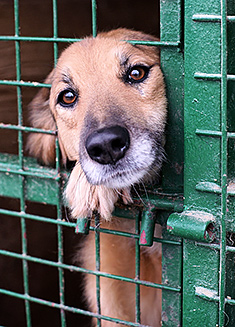Dalmatian Breed Guide
If you only think of the Dalmatian as the dog sitting atop the fire truck, you’ve got another think coming. These active, loyal dogs are great companion animals, even if you don’t live in a firehouse.
Where did the Dalmatian come from?
While some dog breeds can trace their history back to a specific country of origin, the Dalmatian’s origins are something of a mystery. The breed was first shown in England in 1862, but there is a region of Croatia named Dalmatia, which may be where the breed was originally developed as a guard dog.
What are Dalmatians used for?
Because of the Dalmatian’s natural love of other animals including horses, the breed was used historically as a carriage dog, running alongside coaches to keep people and small animals from bothering the horses. This is likely the reason they have been so strongly associated with the fire service, as they assisted early horse-drawn fire engines in getting through crowded streets to a fire. When fire engines became motorized, the Dalmatian retained its status as the firehouse mascot, and may have been used as a guard dog to protect the firehouse, its occupants and equipment.
Similarly, Dalmatians were used to guard horse-drawn beer wagons on their delivery rounds. Even today, the Anheuser-Busch company shows its Clydesdale-driven Budweiser beer wagon with a Dalmatian keeping the driver company. If you look closely at the commercials featuring the Clydesdales, you will nearly always see a Dalmatian somewhere nearby.
Dalmatians have been used as exterminators to keep homes free of rats and other vermin. Drawing on this strong hunting instinct, they have been used in a variety of sporting capacities including retrieving downed birds and pointing the way to hidden game. Because the breed is so distinctive in its markings and is so smart, they have been popular circus dogs throughout the years.
What should a Dalmatian look like?
If you look at a very young Dalmatian puppy, you may be surprised to find he or she is totally white! Not to worry, spots will develop within the first few weeks of life. The most common coloring includes either brown or black spots on a mostly white dog. Liver coloring is recessive, meaning that if you breed two liver-spotted dogs, you will get only liver-spotted puppies, but if you breed two black spotted dogs who carry the recessive gene, you will likely get some black-spotted and some liver-spotted puppies.
There are some less common colors, but they are not allowable in the show ring. These less common spot colors include blue, orange, brindle, mosaic, and tri-color.
A patch of color, most common on the head and ears, is a disqualification for the show ring. Any spot larger than the size of a half-dollar would be considered a patch.
Dalmatians may have brown, amber, or blue eyes, and sometimes have one blue and one brown. Depending on which kennel club is sanctioning a particular show, eye color may or may not be a disqualifying factor. The American Kennel Club accepts blue eyes, while the Canadian Kennel Club does not. In the United Kingdom, black-spotted dogs must have dark eyes, and liver-spotted dogs must have amber eyes to qualify for the show ring.
The fully grown Dalmatian should weigh between 35 and 65 pounds, and stand 19 – 25 inches high at the withers. The body should be approximately square when viewed from the side. The pendulous ears are set fairly high on the head and tapered toward the tip. Toenails should be white or the same color as the spots.
The short, fine fur sheds a lot, all year round. While frequent grooming may cut down on the amount of shedding, nothing eliminates it entirely.
Is it hard to train a Dalmatian?
Dalmatians are very smart dogs and have great memories, making them a delight to train. However, they do have a stubborn streak and do not respond well to harsh training methods such as pinch collars. Training should include lots of praise and attention. Positive training may take a little longer, but produces much better results than punitive training methods.
How does the Dalmatian do in families?
The Dalmatian is a very social dog and will enjoy being part of a family, as long as he is not left alone for long periods of time. They do well with other animals in the home, but should be closely supervised around young or rowdy children.
This breed is very active and has a high exercise need. Those with more sedentary lifestyles should probably consider a different breed. The Dalmatian needs daily exercise, brisk walking at a minimum.
Is the Dalmatian a healthy breed?
Properly and carefully bred, the Dalmatian can be as healthy as any other breed. The average life span is 11 to 13 years, but they can live as long as 17 to 18 years. Most health problems, such as arthritis, result from advancing age.
Male Dalmatians over the age of ten are prone to bladder stones, a very painful condition caused by a problem in the liver. For this reason, parents should limit the amount of calcium and purine fed to the dog. Purine is found in organ meats like liver, and in animal by-products.
The major genetic problem common to Dalmatians is deafness, with about 30% of dogs suffering hearing impairment. It appears that deafness is associated with the light coloration of the coat. Dogs who have patches of color, a show ring disqualification, tend to have a lower rate of deafness. Blue-eyed Dalmatians have a higher incidence of hearing impairment than dogs with brown eyes, which is why some kennel clubs disqualify blue-eyed Dalmatians.
As young as five weeks of age, puppies can and should be tested for deafness using a Brainstem Auditory Evoked Response (BAER) test. Typically, puppies who test as totally deaf are usually euthanized, although there is disagreement as to what to do with puppies who are deaf in only one ear. Before you feel sorry for the euthanized dogs, consider their quality of life. According to the Dalmatian Club of America, adopting a deaf Dalmatian means
you will be letting yourself in for a lot of work and probable heartbreak: work, because the dog cannot hear you, and for all but the most experienced handlers is rendered untrainable; probable heartbreak, because if the dog ever escapes from you, he cannot hear traffic. You can conclude the ending. The deaf dog leads a sadly neurotic life, as every hand on his fur or step on the floor startles him because he cannot hear. Most deaf dogs become so fearful and timid that they must be put to sleep anyway; it is better to do so right after the BAER test proves the dog deaf, before a family is attached to the dog.
Dogs with any hearing impairment should not be bred. If you are seeking a Dalmatian puppy, ask the breeder to show you the results of any BAER testing that has been done on the puppies before you take one home.
101 Dalmatians
The book by Dodie Smith and the two Disney movies based on it resulted in a massive increase in the popularity of the Dalmatian. Unfortunately, many irresponsible people who wanted to make a quick buck began breeding Dalmatians without any thought of genetic planning. Genetic defects were common, and prospective families were not screened to see if they could handle such a high-energy, shedding dog.
After the 1996 re-make of 101 Dalmatians, ownership of Dalmatians surged, but people soon found out that this breed is not the easiest one to have in your home. They shed, and they require daily vigorous exercise. Many dogs ended up in shelters and rescues when families found they simply didn’t want to do this much work for a dog. From 2000 – 2010, there was a 90% decrease in the number of Dalmatians registered with the AKC.
This breed definitely requires that prospective puppy buyers pay attention to breeding. Improperly bred dogs have a high incidence of deafness and other genetic problems. They are also likely to be very hyperactive. Make sure you see the parents before you take the puppy, and ask the breeder lots of questions to ascertain whether or not care was taken to genetically strengthen the breed by selectively mating only certain dogs.
Is the Dalmatian the right breed for me?
If you are looking for a great family companion who is highly intelligent and loyal, the Dalmatian may be just right. However, if you cannot provide adequate exercise opportunities and if shedding bothers you, it might be better to look elsewhere.
One great resource is this list of 101 things to think about before breeding (or buying) a Dalmation from the Dalmation Information Station.
Doggies Den: Latest Articles
 Homemade Thanksgiving Treats for Your Dog
Homemade Thanksgiving Treats for Your Dog
NUTRITION We all want to include our dogs in our holiday celebrations, but hopefully, you're aware that sharing table scraps with your dog isn't always the best idea.
 Keeping Your Dog Safe during the Summer Months
Keeping Your Dog Safe during the Summer Months
HEALTH Summer is coming on fast, so it’s time to plan how you will keep your dog safe and healthy through the lazy, carefree, warm days.
 Vaccination Time Again-Keeping Your Puppy Healthy
Vaccination Time Again-Keeping Your Puppy Healthy
DOG HEALTH So you have your new puppy picked out. There are quite a few shots, treatments and examinations that will keep the newest member of your family healthy.
 Canine Thanksgiving Feast
Canine Thanksgiving Feast
NUTRITION With the wide variety of food at Thanksgiving dinner, chances are you'll want to give your dog something special, too. If you're contemplating what to feed your dog for the holiday, here is a guide to a great Canine Thanksgiving Feast.
 Dog Walking Tips Every Owner Should Know
Dog Walking Tips Every Owner Should Know
DOG FUN Walking your dog is not only crucial to keeping him healthy and happy, it strengthens the bond between your canine friend and his caregiver. There are a lot of obstacles out there. Don’t forget these simple tips to keep your walk fun and safe in the outside world.
 The Benefits of Physiotherapy for your Dog
The Benefits of Physiotherapy for your Dog
HEALTH The same techniques that physiotherapists use to treat a variety of injuries and conditions in humans have been adapted to suit animals with great success. Family pets, show dogs, and working dogs can all benefit greatly from physiotherapy. Dogs whose activities involve a lot of agility are especially susceptible to the types of problems that physiotherapy can address.
 The Decision- Adding a Dog to Your Family
The Decision- Adding a Dog to Your Family
FIRST TIME OWNERSBringing a dog into your family is a decision where many people don’t realize it’s magnitude until after they have the dog. There are a number of things that you need to research before you decide to purchase a dog, and it starts right in your own home.
 Bringing Your Dog Into Your New Baby's Life
Bringing Your Dog Into Your New Baby's Life
HEALTH Many believe that a dog and a new baby cannot happily coexist, so therefore the dog has to go. This is not necessarily the case.  A new baby does not mean you have to abandon your dog.

Doggies Den:
Most Popular Articles

Dog Pregnancy Symptoms
HEALTHIf you suspect your dog might be pregnant, check out part one in this series on pregnant dogs, where we cover pregnant dog symptoms.

Dog Birth
HEALTHIn the third article of our dog pregnancy series, we look at the wonderful, but messy, process of bringing newborn puppies into the world.

Indoor Dog Potties
DOG PRODUCTSIt's been a long day at work. You were so busy, you didn't even take time to eat a sandwich, let alone run home to let your dog out. You're on your way home, knowing the poor dog is crossing his or her legs by now, when your car breaks down, delaying you even further. Can't somebody make this easier?

Your Dog’s Digestive System
PHYSIOLOGYEver wonder why your dog eats so fast? Or why he eats gross things? Or why he gets sick to his stomach? Or why his waste stinks so bad? Some of these things are normal, some are not.

Canine Respiratory System
BREATHINGThe basic function of your dog's respiratory system is to bring oxygen in to and remove carbon dioxide from the body. Knowing the symptoms of respiratory diseases can help you help your stay healthy.

Shelter Dog Adoption Tips for Success
ADOPTION Are you intimidated by the prospect of "rescuing" a dog from a shelter? One reason that you may be wary of adopting a dog from a shelter is not knowing how to choose. Adopting a dog from a shelter can be a rewarding process, if you're prepared to do a reasonable amount of research.

Canine Urinary Tract Infections
SYMPTOMS AND TREATMENTDoes your dog seem to be having trouble relieving his or her bladder? Learn how to recognize the signs of urinary tract infections and how to treat them before they spread.

What to do for Dog Diarrhea
SYMPTOMS AND REMEDIESIf you have dogs in your house for any length of time, you have likely experienced at least one bout of dog diarrhea. Beyond the pain in the tuckus involved in cleaning up the mess, you should know what causes diarrhea, and when it's important to see the vet.

What to do for a Dog Bite
DOG BEHAVIOR Getting bitten by a dog can be scary, and you may be tempted to run around in circles for a while, trying to figure out what to do. Here's our guide to help you manage the situation.

Top Ten Tips for Living with a Senior Dog
DOG HEALTH Bringing home a new puppy is so exciting, but it doesn’t take all that long for your exuberant puppy to grow into a senior dog who may have special needs. Here are the doggies.com top ten tips for taking care of your companion who has been with you through so much.
